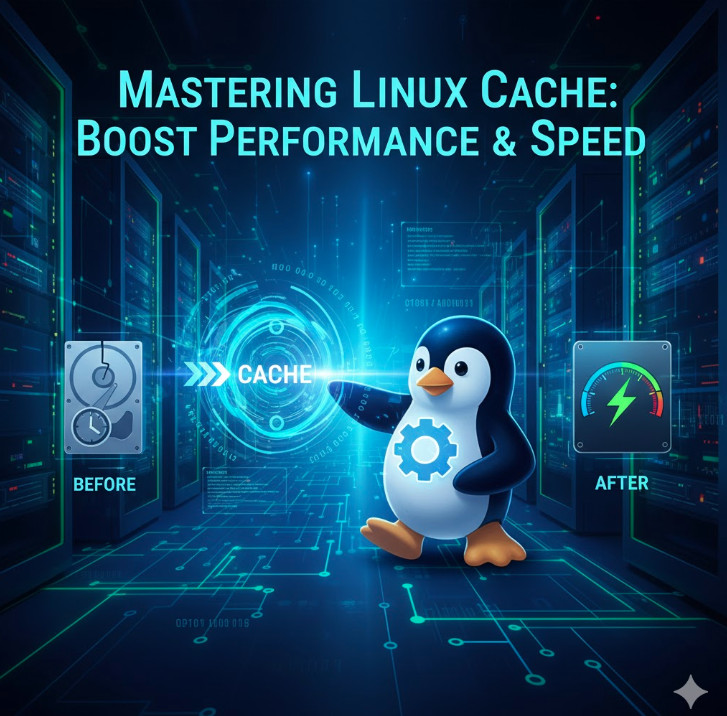In the world of system administration and DevOps, performance is paramount. Every millisecond counts, and one of the most fundamental yet misunderstood components contributing to a Linux system’s speed is its caching mechanism. Many administrators see high memory usage attributed to “cache” and instinctively worry, but this is often a sign of a healthy, well-performing system. Understanding the Linux cache is not just an academic exercise; it’s a practical skill that allows you to accurately diagnose performance issues and optimize your infrastructure. This comprehensive guide will demystify the Linux caching system, from its core components to practical monitoring and management techniques.
Table of Contents
What is the Linux Cache and Why is it Crucial?
At its core, the Linux cache is a mechanism that uses a portion of your system’s unused Random Access Memory (RAM) to store data that has recently been read from or written to a disk (like an SSD or HDD). Since accessing data from RAM is orders of magnitude faster than reading it from a disk, this caching dramatically speeds up system operations.
Think of it like a librarian who keeps the most frequently requested books on a nearby cart instead of returning them to the vast shelves after each use. The next time someone asks for one of those popular books, the librarian can hand it over instantly. In this analogy, the RAM is the cart, the disk is the main library, and the Linux kernel is the smart librarian. This process minimizes disk I/O (Input/Output), which is one of the slowest operations in any computer system.
The key benefits include:
- Faster Application Load Times: Applications and their required data can be served from the cache instead of the disk, leading to quicker startup.
- Improved System Responsiveness: Frequent operations, like listing files in a directory, become almost instantaneous as the required metadata is held in memory.
- Reduced Disk Wear: By minimizing unnecessary read/write operations, caching can extend the lifespan of physical storage devices, especially SSDs.
It’s important to understand that memory used for cache is not “wasted” memory. The kernel is intelligent. If an application requires more memory, the kernel will seamlessly and automatically shrink the cache to free up RAM for the application. This dynamic management ensures that caching enhances performance without starving essential processes of the memory they need.
Diving Deep: The Key Components of the Linux Cache
The term “Linux cache” is an umbrella for several related but distinct mechanisms working together. The most significant components are the Page Cache, Dentry Cache, and Inode Cache.
The Page Cache: The Heart of File Caching
The Page Cache is the main disk cache used by the Linux kernel. When you read a file from the disk, the kernel reads it in chunks called “pages” (typically 4KB in size) and stores these pages in unused areas of RAM. The next time any process requests the same part of that file, the kernel can provide it directly from the much faster Page Cache, avoiding a slow disk read operation.
This also works for write operations. When you write to a file, the data can be written to the Page Cache first (a process known as write-back caching). The system can then inform the application that the write is complete, making the application feel fast and responsive. The kernel then flushes these “dirty” pages to the disk in the background at an optimal time. The sync command can be used to manually force all dirty pages to be written to disk.
The Buffer Cache: Buffering Block Device I/O
Historically, the Buffer Cache (or `Buffers`) was a separate entity that held metadata related to block devices, such as the filesystem journal or partition tables. In modern Linux kernels (post-2.4), the Buffer Cache is not a separate memory pool. Its functionality has been unified with the Page Cache. Today, when you see “Buffers” in tools like free or top, it generally refers to pages within the Page Cache that are specifically holding block device metadata. It’s a temporary storage for raw disk blocks and is a much smaller component compared to the file-centric Page Cache.
The Slab Allocator: Dentry and Inode Caches
Beyond caching file contents, the kernel also needs to cache filesystem metadata to avoid repeated disk lookups for file structure information. This is handled by the Slab allocator, a special memory management mechanism within the kernel for frequently used data structures.
Dentry Cache (dcache)
A “dentry” (directory entry) is a data structure used to translate a file path (e.g., /home/user/document.txt) into an inode. Every time you access a file, the kernel has to traverse this path. The dentry cache stores these translations in RAM. This dramatically speeds up operations like ls -l or any file access, as the kernel doesn’t need to read directory information from the disk repeatedly. You can learn more about kernel memory allocation from the official Linux Kernel documentation.
Inode Cache (icache)
An “inode” stores all the metadata about a file—except for its name and its actual data content. This includes permissions, ownership, file size, timestamps, and pointers to the disk blocks where the file’s data is stored. The inode cache holds this information in memory for recently accessed files, again avoiding slow disk I/O for metadata retrieval.
How to Monitor and Analyze Linux Cache Usage
Monitoring your system’s cache is straightforward with standard Linux command-line tools. Understanding their output is key to getting a clear picture of your memory situation.
Using the free Command
The free command is the quickest way to check memory usage. Using the -h (human-readable) flag makes the output easy to understand.
$ free -h
total used free shared buff/cache available
Mem: 15Gi 4.5Gi 338Mi 1.1Gi 10Gi 9.2Gi
Swap: 2.0Gi 1.2Gi 821Mi
Here’s how to interpret the key columns:
- total: Total installed RAM.
- used: Memory actively used by applications (total – free – buff/cache).
- free: Truly unused memory. This number is often small on a busy system, which is normal.
- buff/cache: This is the combined memory used by the Page Cache, Buffer Cache, and Slab allocator (dentries and inodes). This is the memory the kernel can reclaim if needed.
- available: This is the most important metric. It’s an estimation of how much memory is available for starting new applications without swapping. It includes the “free” memory plus the portion of “buff/cache” that can be easily reclaimed.
Understanding /proc/meminfo
For a more detailed breakdown, you can inspect the virtual file /proc/meminfo. This file provides a wealth of information that tools like free use.
$ cat /proc/meminfo | grep -E '^(MemAvailable|Buffers|Cached|SReclaimable)'
MemAvailable: 9614444 kB
Buffers: 345520 kB
Cached: 9985224 kB
SReclaimable: 678220 kB
- MemAvailable: The same as the “available” column in
free. - Buffers: The memory used by the buffer cache.
- Cached: Memory used by the page cache, excluding swap cache.
- SReclaimable: The part of the Slab memory (like dentry and inode caches) that is reclaimable.
Advanced Tools: vmstat and slabtop
For dynamic monitoring, vmstat (virtual memory statistics) is excellent. Running vmstat 2 will give you updates every 2 seconds.
$ vmstat 2
procs -----------memory---------- ---swap-- -----io---- -system-- ------cpu-----
r b swpd free buff cache si so bi bo in cs us sy id wa st
1 0 1252348 347492 345632 10580980 2 5 119 212 136 163 9 2 88 1 0
...
Pay attention to the bi (blocks in) and bo (blocks out) columns. High, sustained numbers here indicate heavy disk I/O. If these values are low while the system is busy, it’s a good sign that the cache is effectively serving requests.
To inspect the Slab allocator directly, you can use slabtop.
# requires root privileges
sudo slabtop
This command provides a real-time view of the top kernel caches, allowing you to see exactly how much memory is being used by objects like dentry and various inode caches.
Managing the Linux Cache: When and How to Clear It
Warning: Manually clearing the Linux cache is an operation that should be performed with extreme caution and is rarely necessary on a production system. The kernel’s memory management algorithms are highly optimized. Forcing a cache drop will likely degrade performance temporarily, as the system will need to re-read required data from the slow disk.
Why You Might *Think* You Need to Clear the Cache
The most common reason administrators want to clear the cache is a misunderstanding of the output from free -h. They see a low “free” memory value and a high “buff/cache” value and assume the system is out of memory. As we’ve discussed, this is the intended behavior of a healthy system. The only legitimate reason to clear the cache is typically for benchmarking purposes—for example, to measure the “cold-start” performance of an application’s disk I/O without any caching effects.
The drop_caches Mechanism: The Right Way to Clear Cache
If you have a valid reason to clear the cache, Linux provides a non-destructive way to do so via the /proc/sys/vm/drop_caches interface. For a detailed explanation, resources like Red Hat’s articles on memory management are invaluable.
First, it’s good practice to write all cached data to disk to prevent any data loss using the sync command. This flushes any “dirty” pages from memory to the storage device.
# First, ensure all pending writes are completed
sync
Next, you can write a value to drop_caches to specify what to clear. You must have root privileges to do this.
- To free pagecache only:
echo 1 | sudo tee /proc/sys/vm/drop_caches - To free reclaimable slab objects (dentries and inodes):
echo 2 | sudo tee /proc/sys/vm/drop_caches - To free pagecache, dentries, and inodes (most common):
echo 3 | sudo tee /proc/sys/vm/drop_caches
Example: Before and After
Let’s see the effect.
Before:
$ free -h
total used free shared buff/cache available
Mem: 15Gi 4.5Gi 338Mi 1.1Gi 10Gi 9.2Gi
Action:
$ sync; echo 3 | sudo tee /proc/sys/vm/drop_caches
3
After:
$ free -h
total used free shared buff/cache available
Mem: 15Gi 4.4Gi 10Gi 1.1Gi 612Mi 9.6Gi
As you can see, the buff/cache value dropped dramatically from 10Gi to 612Mi, and the free memory increased by a corresponding amount. However, the system’s performance will now be slower for any operation that needs data that was just purged from the cache.
Frequently Asked Questions
- What’s the difference between buffer and cache in Linux?
- Historically, buffers were for raw block device I/O and cache was for file content. In modern kernels, they are unified. “Cache” (Page Cache) holds file data, while “Buffers” represents metadata for block I/O, but both reside in the same memory pool.
- Is high cache usage a bad thing in Linux?
- No, quite the opposite. High cache usage is a sign that your system is efficiently using available RAM to speed up disk operations. It is not “wasted” memory and will be automatically released when applications need it.
- How can I see what files are in the page cache?
- There isn’t a simple, standard command for this, but third-party tools like
vmtouchorpcstatcan analyze a file or directory and report how much of it is currently resident in the page cache. - Will clearing the cache delete my data?
- No. Using the
drop_cachesmethod will not cause data loss. The cache only holds copies of data that is permanently stored on the disk. Runningsyncfirst ensures that any pending writes are safely committed to the disk before the cache is cleared.

Conclusion
The Linux cache is a powerful and intelligent performance-enhancing feature, not a problem to be solved. By leveraging unused RAM, the kernel significantly reduces disk I/O and makes the entire system faster and more responsive. While the ability to manually clear the cache exists, its use cases are limited almost exclusively to specific benchmarking scenarios. For system administrators and DevOps engineers, the key is to learn how to monitor and interpret cache usage correctly using tools like free, vmstat, and /proc/meminfo. Embracing and understanding the behavior of the Linux cache is a fundamental step toward mastering Linux performance tuning and building robust, efficient systems.Thank you for reading the DevopsRoles page!


